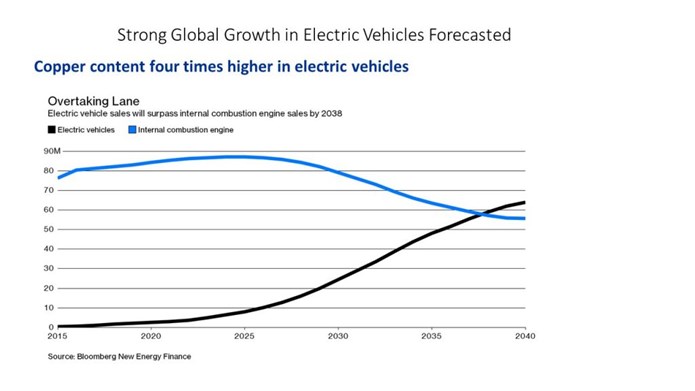Market for copper and zinc
Copper
Copper conducts electricity and heat very well, which makes the metal a necessary raw material in modern economies and societies. More than half of all copper produced today is used to produce and manage electricity. Copper and copper alloys are used in areas where high conductivity (both for electricity and heat), good corrosion resistance, color, formability, strength and soldering are important. Virtually all wires for electrical installations in houses are made of copper as well as electrical conductors in electric generators and motors. Copper is also important in the telecommunications field.
The metal is a very important part of the transition to alternative energy sources, such as solar, wind and water power, which require large amounts of copper to generate electricity and to transfer long distances efficiently. For the electric vehicles market, copper is essential and an electric car needs four times more copper than a car with a combustion engine. The availability of copper is thus one of the most important factors for efficient energy conversion.
As for price trends for the next few years, many analysts (including investment bank Clarksons Platou Securities) expect increasing demand for copper driven by electrification of industry, transport and home. The expected growth of electric vehicles is an important driver, see below forecast from Bloomberg.

Zinc
Zinc is a very important metal for sustainable economic development and it is the fourth most used metal after iron, aluminum and copper. Areas of use are many, but a key application is to prevent corrosion in steel. A thin layer of zinc, so-called galvanizing, extends the life of steel structures by 50 to 100 years by preventing rust. Hence, the consumption of iron ore can be reduced which results in lower amounts of carbon dioxide emissions. Investments in infrastructure become more durable.
Approximately 60% of the annual global consumption of zinc is used for electroplating (source: Boliden). The infrastructure and construction industries are thus the largest users of zinc, but the automotive and electronics industries are also important end-users for, among other things, manufacuring of batteries. Geographically, China accounts for about 50% of the annual zinc consumption in the world.
According to Statista, global mining production of zinc amounted to 13.2 million tonnes and the production of zinc to 13.7 million tonnes. Global consumption of zinc metal amounted to 14.2 million tonnes. The largest producers were China, Peru, Australia, USA and India.
Based on various supply and demand factors, many analysts are positive to a continued strong development for the zinc price over the next few years.